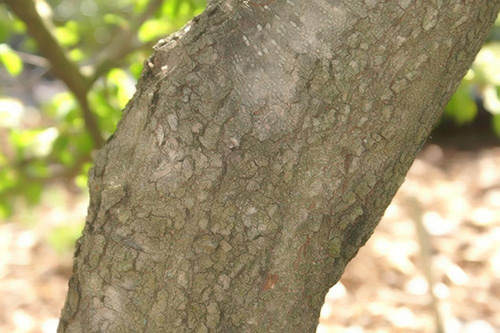Contents
Nature is full of surprises that leave us in awe with its stunning beauty and diverse range of flora and fauna. One such wonder plant is the Black haw viburnum (Viburnum prunifolium), whose bark holds many unique characteristics and potential benefits worth exploring. Let us deeply understand everything about this fascinating plant bark, including physical attributes, ecological significance, historical uses, and medicinal properties. Join us on an enlightening journey through the world of Black Haw Viburnums’ remarkable bark!
Black Haw Viburnum Bark – Physical Characteristics

The black haw viburnum is a deciduous shrub or small tree from the eastern United States. Its visually striking and intricate bark pattern makes it stand out among other plants in its class. As time passes, this plant changes- starting with smooth, light gray bark when young before transforming into a darker textured appearance as it matures. The varying colors make for an exciting sight to behold!
Upon closer examination, numerous horizontal lenticels can be detected scattered across the bark’s surface. These tiny openings facilitate gas exchange between internal tissues and external surroundings, making them essential for plant respiration and ensuring optimal functioning and health maintenance.
Ecological Significance
Due to its versatility and resilience, black haw viburnum is integral to many ecosystems. It can thrive in diverse environments ranging from moist woodlands to upland forests, making it a valuable asset within these habitats. The plant serves as both shelter and sustenance for various wildlife, including birds, mammals, and insects, thereby contributing significantly to maintaining biodiversity levels within areas where it grows naturally. Overall, Black Haw Viburnums’ presence is vital in promoting balance within the environment by harmoniously supporting multiple species’ coexistence.
Historical Uses
Indigenous communities and early settlers recognized the versatility of this bark for centuries. Native American tribes utilized it medicinally by brewing teas or creating poultices to address various ailments. At the same time, European settlers adopted these traditional practices as well, considering them an essential component in their herbal pharmacopeia. The value placed on this resource highlights its importance across cultures throughout history.
The Advantages of Black Haw Viburnum
The Black haw herb has been recognized for supporting women’s health for centuries. This revered plant contains potent uterine tonic properties, making it an invaluable tool for addressing gynecological concerns such as menstrual cramps or irregular cycles. Its muscle relaxant effects may also help alleviate discomfort associated with menopause by reducing spasms and cramping within the uterus. This powerful natural remedy allows women to experience relief during their monthly cycle while maintaining optimal overall wellness.

Relaxes Your Muscles and reduces tension
Beyond its significance for women’s health, the black haw herb has been recognized as a mild muscle relaxant with remarkable properties. Its gentle action on smooth muscles alleviates tension and spasms throughout the body, making it helpful in treating conditions such as gastrointestinal discomfort, muscle cramps, or even headaches caused by stress. These possible uses make this plant-based therapy a valuable complement to any holistic treatment strategy to enhance general well-being.
Antioxidant and Anti-inflammatory Properties
Black haw roots may have anti-inflammatory properties thanks to their abundance of beneficial substances, such as flavonoids and phenolic acids. These bioactive components may help alleviate bodily discomfort caused by chronic conditions such as arthritis or gastrointestinal issues. Additionally, the antioxidant properties present in black haw could aid in reducing oxidative stress, which can lead to cellular damage over time if left unchecked.
Traditional Uses and Modern Validation of Traditional Medicine
- Parts of the plant used: Bark of the root
- Properties: Antispasmodic, emmenagogue, sedative, tonic
- What it affects: Uterus, nerves, stomach, and intestines
Several studies have investigated how this herb affects women’s health concerns and muscle relaxation producing promising results. However, further investigation is necessary before fully understanding all aspects of using it therapeutically. The mechanisms behind these effects remain unknown but may soon become more apparent with ongoing research.
Forms of Administration
Black haw is a versatile remedy in various forms, such as teas, tinctures, capsules, and extracts. However, not all products are created equal; choosing one with proven quality is crucial for optimal results without compromising safety. To avoid any adverse reactions start by taking small doses before gradually increasing if necessary based on personal responses.
- Infusion – Steep for thirty minutes and take three ounces 3 to 4 times daily.
- Decoction – Take one tablespoon 3 to 4 times daily or as needed.
- Tincture – Take ½ to one teaspoon 3 to 4 times daily.
- Fluid Extract – Take ½ to two teaspoons 3 to 4 times daily.
- Powder: Take five to ten #0 capsules (30 to 60 grains) three to four times daily.
Black Haw Viburnum Side Effects
This herb is generally considered safe when used appropriately. However, it might have specific adverse effects and interactions, like any other natural medicine, necessitating care. Before consuming the herb, speaking with a licensed healthcare provider is essential, particularly if you’re expecting, nursing, or taking medication for underlying medical concerns. Potential dangers include:

Those allergic to this herb or other Viburnum genus plants may have an allergic response. Skin rashes, itchy hives, and respiratory problems are possible side effects. If you notice any of these, stop using it at once. When using supplements like this one, safety should always come first.
Black haw may cause mild gastrointestinal discomforts such as upset stomach, nausea, or diarrhea. If these symptoms occur, reduce the dosage, or consider stopping use altogether to avoid further complications.
It has been found to subtly impact blood pressure. Individuals with low blood pressure should exercise caution while using this plant, as it may worsen their condition. They must consult an expert before incorporating any new supplement or medication into their routine.
The use of Black haw during pregnancy and lactation is not yet fully understood. Traditional practices suggest it may impact uterine contractions; therefore, it is advisable to avoid using this plant while carrying a child or breastfeeding. Nursing mothers should exercise caution when considering using black haw by consulting with their healthcare provider first.
Medications, including blood thinners, antiplatelet medicines, and those that alter blood pressure, may interact with the plant. You must inform your doctor about any supplements you take so they can look out for interactions. Don’t risk complications by keeping this information from them!
Black haw has been known to possess mild muscle relaxant properties that could lead to a soothing effect in some individuals. Therefore, it is advised not to drive heavy equipment or do other tasks demanding total concentration until the effects have entirely worn off if you feel exhausted after using the herb.
In addition, those with hormone-sensitive illnesses like breast cancer or endometriosis should exercise care and see a doctor before using this herb. It can also impact bleeding, posing a risk for individuals preparing for surgery. As mentioned numerous times in this article, disclosing any use of herbal supplements with your healthcare provider is essential, especially before an operation.
Remember that herbal remedies can have varying effects on different individuals. It’s critical to begin with a little dose and monitor how your body reacts. If you have any adverse side effects, stop using it right away. This medicinal wonder possesses many health benefits; however, safety should always be a priority.
The black haw viburnum is a testament to nature’s ingenuity. Its striking bark has made it an object of fascination throughout history – from traditional remedies used by indigenous peoples to potential modern medicinal applications explored today.
This plant is yet another example of how nature can provide valuable resources if we use them responsibly. When encountering the black haw viburnum, take a moment to admire its intricate bark patterns and consider what secrets it may hold.
Health Disclaimer: The information on this website is for educational uses only and is not a substitute for professional medical advice. Always consult an authorized healthcare provider for any health concerns before using any herbal or natural remedy. We do not establish, treat, cure, or prevent any disease. Reliance on any material from this website is solely at your own risk. We are not responsible for any adverse effects resulting from the use of information or products mentioned on this website.
REFERENCES
- Vance Ferrell Harold M. Cherne, M.D. The Natural Remedies Encyclopedia [Book]. – Altamont, TN: Harvestime Books, 2010. – Vol. Seventh Edition: 7: pp. 145.
- National Center for Biotechnology Information (NCBI): https://www.ncbi.nlm.nih.gov
- Journal of Ethnopharmacology: https://www.journals.elsevier.com/journal-of-ethnopharmacology
- American Botanical Council: https://www.herbalgram.org
- National Institutes of Health (NIH): https://www.nih.gov
